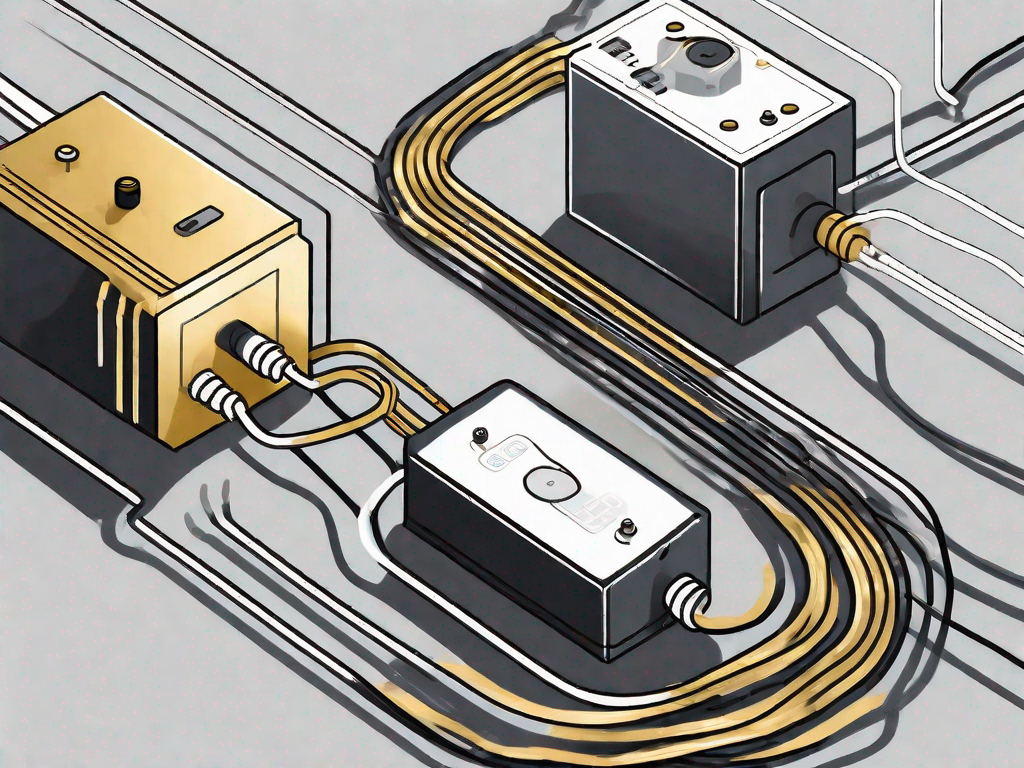
Training requirements for EST4 system operation
Effective training is crucial for ensuring the successful operation of the EST4 system. As a highly advanced and complex fire alarm system, understanding its intricacies is essential for anyone responsible for its operation. This article aims to provide a comprehensive guide to the training requirements for operating the EST4 system, covering everything from understanding the system to maintaining proficiency.
Understanding the EST4 System
The EST4 system is a state-of-the-art fire alarm system designed to provide reliable and efficient fire detection and notification. It incorporates advanced features and technologies that allow for quick response and accurate detection of fire incidents. Familiarizing oneself with the key features and technical specifications of the EST4 system is the first step towards becoming a competent operator.
The EST4 system is not just an ordinary fire alarm system. It is a comprehensive solution that combines cutting-edge technology with intelligent design to ensure the safety of occupants in any building. With its advanced features, the EST4 system offers unparalleled protection against fire hazards.
Key Features of the EST4 System
The EST4 system boasts several key features that set it apart from other fire alarm systems. These include intelligent smoke detection, advanced emergency communication capabilities, and integrated voice evacuation systems. Understanding how each of these features contributes to the overall functionality of the system is essential for effective operation.
Intelligent smoke detection is one of the standout features of the EST4 system. It utilizes advanced algorithms and sensors to accurately detect the presence of smoke and differentiate it from other airborne particles. This ensures that false alarms are minimized, allowing for a more efficient response to genuine fire incidents.
In addition to its smoke detection capabilities, the EST4 system also excels in emergency communication. It is equipped with advanced communication modules that enable seamless integration with emergency response teams and authorities. This ensures that the appropriate personnel are alerted promptly, allowing for a swift and coordinated response to any fire emergency.
Furthermore, the EST4 system incorporates integrated voice evacuation systems. These systems provide clear and concise voice instructions to occupants in the event of a fire. By guiding individuals to the nearest exits and providing real-time updates, the voice evacuation systems enhance the overall safety and evacuation process, minimizing the risk of injuries or confusion.
Technical Specifications of the EST4 System
Having a solid grasp of the technical specifications of the EST4 system is crucial for troubleshooting and maintaining its operational integrity. This includes understanding the system’s power requirements, networking capabilities, and compatibility with other fire protection components. Such knowledge allows operators to diagnose and address potential system issues efficiently.
The EST4 system operates on a reliable power supply, ensuring continuous functionality even during power outages. It is designed to work with both AC and DC power sources, providing flexibility and reliability in various building environments. Additionally, the system’s networking capabilities allow for seamless integration with other building management systems, providing a comprehensive approach to fire safety.
Compatibility is another important aspect of the EST4 system’s technical specifications. It is designed to work harmoniously with a wide range of fire protection components, including smoke detectors, heat detectors, and sprinkler systems. This compatibility ensures that the EST4 system can be seamlessly integrated into existing fire protection infrastructures, maximizing its effectiveness and minimizing installation complexities.
In conclusion, the EST4 system is a state-of-the-art fire alarm system that offers advanced features and technologies to ensure reliable and efficient fire detection and notification. By understanding its key features and technical specifications, operators can effectively operate and maintain the system, providing a safe environment for building occupants.
Importance of Proper Training for EST4 System Operation
While the EST4 system boasts advanced features, it also presents risks when operated by individuals without proper training. Inadequate training can lead to improper system configuration, delayed response to fire incidents, and compromised life safety. Understanding the risks associated with inadequate training reinforces the need for comprehensive training programs.
Risks of Inadequate Training
Inadequate training increases the likelihood of false alarms, which can be disruptive and costly. It also raises the risk of delayed evacuation during actual emergencies, jeopardizing lives and property. Additionally, mishandling the system due to inadequate training can result in malfunctions, leading to reduced system reliability and potentially catastrophic consequences.
One of the major risks of inadequate training is the potential for false alarms. False alarms not only disrupt the normal operations of a facility but can also lead to unnecessary panic among occupants. This can cause confusion and hinder the evacuation process during a real emergency. With proper training, operators can learn to differentiate between genuine fire incidents and false alarms, ensuring a swift and appropriate response.
Another risk associated with inadequate training is the possibility of delayed evacuation during actual emergencies. Without the necessary knowledge and skills, operators may not be able to quickly assess the situation and take appropriate action. This delay in evacuation can have severe consequences, as every second counts when it comes to saving lives and minimizing property damage.
In addition to false alarms and delayed evacuation, mishandling the EST4 system due to inadequate training can result in malfunctions. Improper configuration or operation of the system can lead to technical issues, compromising its reliability. A malfunctioning fire alarm system can fail to detect fires or provide timely alerts, putting lives and property at risk. Comprehensive training programs can equip operators with the expertise to identify and address potential system malfunctions, ensuring the system remains in optimal working condition.
Benefits of Comprehensive Training
Comprehensive training programs offer operators the knowledge and skills required to operate the EST4 system effectively. Such training not only mitigates risks but also enhances the ability to respond swiftly and accurately to fire incidents. Additionally, comprehensive training empowers operators to conduct routine maintenance tasks, ensuring the system remains in optimal working condition.
One of the key benefits of comprehensive training is the ability to respond swiftly and accurately to fire incidents. Properly trained operators can quickly assess the situation, activate the appropriate response protocols, and initiate evacuation procedures if necessary. This rapid response can significantly reduce the potential for injuries and property damage, as well as minimize the overall impact of the fire incident.
Moreover, comprehensive training programs enable operators to conduct routine maintenance tasks on the EST4 system. Regular maintenance is crucial for ensuring the system’s optimal performance and reliability. Trained operators can perform inspections, test the system’s components, and identify any potential issues before they escalate into major problems. By proactively addressing maintenance needs, comprehensive training helps to prevent system failures and ensures the system is always ready to respond effectively in case of a fire.
In conclusion, the importance of proper training for EST4 system operation cannot be overstated. Inadequate training poses significant risks, including false alarms, delayed evacuation, and system malfunctions. On the other hand, comprehensive training programs offer numerous benefits, such as the ability to respond swiftly and accurately to fire incidents and the capability to conduct routine maintenance tasks. Investing in comprehensive training not only safeguards lives and property but also enhances the overall effectiveness and reliability of the EST4 system.
Components of Effective EST4 System Training
Effective EST4 system training comprises both theoretical knowledge and practical skills. This multifaceted approach equips operators with the necessary understanding and hands-on experience to operate the system confidently and competently.
Theoretical Knowledge
Theoretical training covers an in-depth understanding of the EST4 system’s architecture, operation principles, and relevant codes or regulations. Operators gain knowledge of system components, their interdependencies, and the proper configuration of each element to ensure seamless functionality.
During theoretical training, operators delve into the intricacies of the EST4 system’s architecture. They learn about the various modules and how they work together to provide a comprehensive fire detection and alarm solution. Operators also gain a thorough understanding of the system’s operation principles, including how it detects and responds to fire incidents, as well as its integration with other building systems.
Furthermore, theoretical training includes an exploration of the relevant codes and regulations that govern the installation and operation of fire detection and alarm systems. Operators become familiar with the specific requirements and standards that must be adhered to, ensuring compliance and optimal system performance.
Practical Skills
Practical training involves hands-on experience in system installation, maintenance, and troubleshooting. Operators learn how to navigate the system’s user interface, interpret alarms and notifications, and perform routine tests and inspections. Mastering practical skills ensures operators can respond effectively to system alarms and address any issues that arise.
During practical training, operators have the opportunity to work with the EST4 system in a simulated environment. They learn how to install the system components correctly, ensuring proper wiring and connections. Operators also gain hands-on experience in system maintenance, including regular cleaning, testing, and calibration of sensors and devices.
Moreover, practical training focuses on troubleshooting skills, equipping operators with the ability to identify and resolve system faults and malfunctions. They learn how to interpret alarms and notifications, distinguishing between false alarms and genuine fire incidents. Operators also practice responding to different emergency scenarios, ensuring they can take appropriate action swiftly and efficiently.
Additionally, operators are trained to conduct routine tests and inspections to ensure the ongoing functionality and reliability of the EST4 system. They learn how to perform regular system checks, including testing smoke detectors, checking battery levels, and verifying communication pathways. These routine tasks are essential in maintaining the system’s optimal performance and minimizing the risk of false alarms or system failures.
In conclusion, effective EST4 system training encompasses both theoretical knowledge and practical skills. By combining a comprehensive understanding of the system’s architecture, operation principles, and relevant codes with hands-on experience in installation, maintenance, and troubleshooting, operators are equipped to operate the EST4 system confidently and competently.
Training Methods for EST4 System Operation
The training methods used for EST4 system operation are diverse, catering to different learning preferences and circumstances. Common training methods include classroom-based training, online training modules, and on-the-job training.
Classroom-Based Training
Classroom-based training is a traditional but effective method for providing operators with hands-on experience and face-to-face interaction with instructors. This approach allows for real-time demonstrations, group discussions, and immediate feedback, enhancing the learning experience. Classroom-based training also fosters collaboration among operators, facilitating knowledge exchange and the development of problem-solving skills.
During classroom-based training, operators are exposed to various scenarios and challenges that they may encounter while operating the EST4 system. They have the opportunity to practice their skills in a controlled environment, under the guidance of experienced instructors. This method ensures that operators are well-prepared to handle any situation that may arise during actual system operation.
Additionally, classroom-based training provides a structured learning environment, where operators can focus solely on acquiring the necessary knowledge and skills. They are able to dedicate their time and attention to the training materials, without any distractions or interruptions. This focused learning approach allows for better retention and understanding of the EST4 system operation.
Online Training Modules
Online training modules provide flexibility and accessibility for operators who cannot attend in-person classes. These modules consist of interactive presentations, quizzes, and simulations, allowing operators to learn at their own pace and convenience. Online training modules often include progress tracking and assessment features, ensuring operators meet the required competency levels.
One of the key advantages of online training modules is the ability to access training materials from anywhere, at any time. This is particularly beneficial for operators who are located in remote areas or have busy schedules. They can log in to the training platform and complete the modules at their own convenience, without the need to travel or adhere to specific class schedules.
Furthermore, online training modules can be customized to cater to the specific needs and learning styles of individual operators. The modules can be designed to include interactive elements, such as videos, animations, and simulations, which enhance engagement and understanding. Operators can also revisit the modules as many times as needed, reinforcing their knowledge and skills in operating the EST4 system.
On-the-Job Training
In addition to classroom-based training and online modules, on-the-job training is another important method for training operators in EST4 system operation. This method involves operators working alongside experienced professionals, gaining hands-on experience and practical knowledge in a real-world setting.
During on-the-job training, operators have the opportunity to apply the theoretical knowledge gained from classroom-based training and online modules to actual operational scenarios. They can observe and learn from experienced operators, who can provide guidance and mentorship throughout the training process. This method allows for the development of practical skills, problem-solving abilities, and the ability to adapt to different situations.
On-the-job training also provides operators with a deeper understanding of the EST4 system’s functionalities and intricacies. They can witness firsthand how the system operates in various scenarios, including routine operations and emergency situations. This immersive learning experience helps operators become more confident and competent in their roles, ensuring the smooth and efficient operation of the EST4 system.
Assessing Competency in EST4 System Operation
Assessing and certifying an operator’s competency in EST4 system operation is a critical step towards ensuring reliable and consistent performance. It is essential to have operators who are knowledgeable and skilled in operating the EST4 system, as it plays a crucial role in various industries, including fire protection and emergency response.
When it comes to assessing competency, there are several methods and criteria that can be employed to evaluate an operator’s knowledge and skills. These methods aim to provide a comprehensive understanding of an operator’s capabilities and ensure they can effectively operate the system in real-world situations.
Evaluation Methods
The evaluation methods used for assessing competency may include written exams, practical assessments, and simulated emergency scenarios. Written exams are designed to test an operator’s theoretical knowledge of the EST4 system. These exams cover topics such as system components, operating procedures, troubleshooting techniques, and safety protocols. By assessing an operator’s theoretical understanding, written exams provide a foundation for evaluating their overall competence.
Practical assessments are another crucial component of evaluating an operator’s competency. These assessments involve hands-on tasks that require operators to demonstrate their ability to operate the EST4 system effectively. Operators may be evaluated on their proficiency in system navigation, alarm response, system configuration, and maintenance procedures. Practical assessments provide a practical application of an operator’s knowledge and ensure they can perform their duties efficiently.
In addition to written exams and practical assessments, simulated emergency scenarios are often used to evaluate an operator’s ability to handle critical situations. These scenarios recreate real-world emergencies, allowing operators to demonstrate their decision-making skills, problem-solving abilities, and response strategies. Simulated emergency scenarios provide a realistic and controlled environment for operators to showcase their competence under pressure.
Certification Process
Upon successful completion of the evaluation process, operators can receive certification to validate their competence in EST4 system operation. Certification serves as a recognized credential that sets operators apart and assures employers and clients of their proficiency. It demonstrates that operators have met the necessary standards and have the necessary skills to operate the EST4 system effectively.
The certification process typically involves a thorough review of an operator’s evaluation results, including their performance in written exams, practical assessments, and simulated emergency scenarios. Certification bodies may also consider an operator’s experience and training history in the field of system operation. This comprehensive assessment ensures that certified operators are well-rounded and capable of handling various challenges that may arise during system operation.
It is important to note that certification is not a one-time achievement. To maintain their certification, operators are required to participate in regular renewal processes. These renewal processes may involve additional training, continuing education, and assessments to ensure operators stay up to date with the latest system advancements and best practices. By continuously updating their knowledge and skills, certified operators can adapt to evolving technologies and industry standards, further enhancing their competence in EST4 system operation.
In conclusion, assessing and certifying an operator’s competency in EST4 system operation is a comprehensive process that involves various evaluation methods and criteria. It ensures that operators have the necessary knowledge, skills, and abilities to operate the system effectively. Certification serves as a recognized credential that sets operators apart and assures employers and clients of their proficiency. By participating in regular renewal processes, certified operators can stay up to date with system advancements and best practices, further enhancing their competence in EST4 system operation.
Maintaining Proficiency in EST4 System Operation
Proficiency in EST4 system operation requires ongoing commitment and continuous learning. Regular refresher courses and staying updated with system updates and continuing education are vital for maintaining competence.
Regular Refresher Courses
Refresher courses allow operators to revisit and reinforce their knowledge and skills. These courses provide an opportunity to address any knowledge gaps, refresh system operation techniques, and update operators on any new regulations or industry standards. Regular refresher courses ensure operators remain confident in their abilities and stay informed.
Updates and Continuing Education
The field of fire protection constantly evolves, and the EST4 system is no exception. Staying updated with system updates, industry trends, and new technologies is essential for operators to adapt and enhance their skillset. Engaging in continuing education programs, industry conferences, and networking events helps operators broaden their knowledge and stay current in their profession.
In conclusion, proper training requirements for operating the EST4 system are crucial to ensure operators possess the knowledge and skills necessary for efficient and effective fire alarm system operation. Understanding the system, recognizing the importance of comprehensive training, and staying proficient through ongoing learning are key ingredients for successful operation. By investing in comprehensive training programs and promoting continuous professional development, operators can maximize the benefits of the EST4 system and contribute to enhanced life safety.


